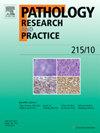The emerging role of artificial intelligence in neuropathology: Where are we and where do we want to go?
IF 2.9
4区 医学
Q2 PATHOLOGY
引用次数: 0
Abstract
The field of neuropathology, a subspecialty of pathology which studies the diseases affecting the nervous system, is experiencing significant changes due to advancements in artificial intelligence (AI). Traditionally reliant on histological methods and clinical correlations, neuropathology is now experiencing a revolution due to the development of AI technologies like machine learning (ML) and deep learning (DL). These technologies enhance diagnostic accuracy, optimize workflows, and enable personalized treatment strategies. AI algorithms excel at analyzing histopathological images, often revealing subtle morphological changes missed by conventional methods. For example, deep learning models applied to digital pathology can effectively differentiate tumor grades and detect rare pathologies, leading to earlier and more precise diagnoses. Progress in neuroimaging is another helpful tool of AI, as enhanced analysis of MRI and CT scans supports early detection of neurodegenerative diseases. By identifying biomarkers and progression patterns, AI aids in timely therapeutic interventions, potentially slowing disease progression. In molecular pathology, AI’s ability to analyze complex genomic data helps uncover the genetic and molecular basis of neuropathological conditions, facilitating personalized treatment plans. AI-driven automation streamlines routine diagnostic tasks, allowing pathologists to focus on complex cases, especially in settings with limited resources. This review explores AI's integration into neuropathology, highlighting its current applications, benefits, challenges, and future directions.
人工智能在神经病理学中的新兴角色:我们在哪里,我们想去哪里?
神经病理学是研究影响神经系统疾病的病理学分支学科,由于人工智能(AI)的进步,神经病理学领域正在经历重大变革。神经病理学传统上依赖于组织学方法和临床相关性,现在由于机器学习(ML)和深度学习(DL)等人工智能技术的发展,神经病理学正在经历一场革命。这些技术提高了诊断的准确性,优化了工作流程,并实现了个性化治疗策略。人工智能算法擅长分析组织病理学图像,往往能揭示传统方法所忽略的细微形态变化。例如,应用于数字病理学的深度学习模型可以有效区分肿瘤等级并检测罕见病理,从而更早、更准确地做出诊断。神经成像方面的进展是人工智能的另一个有用工具,因为增强的核磁共振成像和 CT 扫描分析有助于早期检测神经退行性疾病。通过识别生物标志物和进展模式,人工智能有助于及时采取治疗干预措施,从而有可能减缓疾病的进展。在分子病理学方面,人工智能分析复杂基因组数据的能力有助于揭示神经病理学疾病的基因和分子基础,从而促进个性化治疗方案的制定。人工智能驱动的自动化简化了常规诊断任务,使病理学家能够专注于复杂病例,尤其是在资源有限的情况下。本综述探讨了人工智能与神经病理学的结合,重点介绍了其当前的应用、优势、挑战和未来发展方向。
本文章由计算机程序翻译,如有差异,请以英文原文为准。
求助全文
约1分钟内获得全文
求助全文
来源期刊
CiteScore
5.00
自引率
3.60%
发文量
405
审稿时长
24 days
期刊介绍:
Pathology, Research and Practice provides accessible coverage of the most recent developments across the entire field of pathology: Reviews focus on recent progress in pathology, while Comments look at interesting current problems and at hypotheses for future developments in pathology. Original Papers present novel findings on all aspects of general, anatomic and molecular pathology. Rapid Communications inform readers on preliminary findings that may be relevant for further studies and need to be communicated quickly. Teaching Cases look at new aspects or special diagnostic problems of diseases and at case reports relevant for the pathologist''s practice.

 求助内容:
求助内容: 应助结果提醒方式:
应助结果提醒方式:


